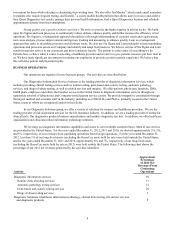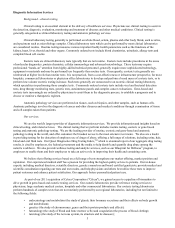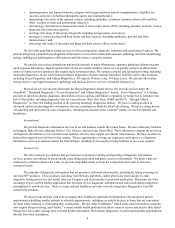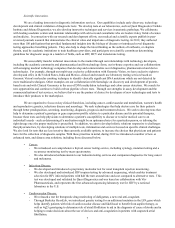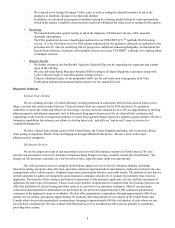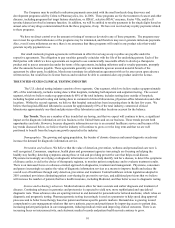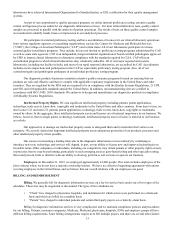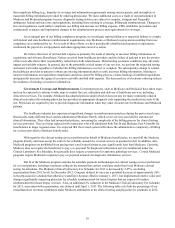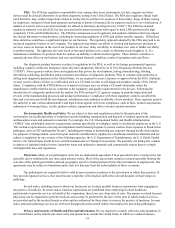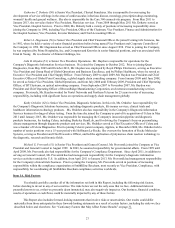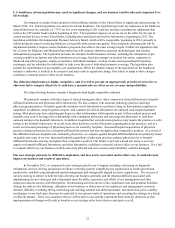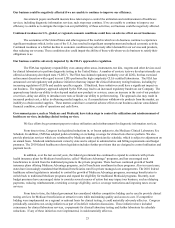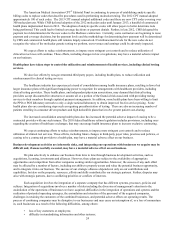Quest Diagnostics 2012 Annual Report Download - page 17
Download and view the complete annual report
Please find page 17 of the 2012 Quest Diagnostics annual report below. You can navigate through the pages in the report by either clicking on the pages listed below, or by using the keyword search tool below to find specific information within the annual report.14
to us. As a result of these affiliations, we compete against hospital-affiliated laboratories primarily on the basis of service
capability and quality as well as other non-pricing factors. In addition, recent market activity may increase the competitive
environment. For example, health plan actions to exclude large national providers from contracts may enhance the relative
competitive position of regional providers. In addition, increased hospital acquisitions of physician practices enhance the ties
of the physicians to hospital-affiliated laboratories, enhancing the competitive position of hospital-affiliated laboratories.
The diagnostic information services industry is faced with changing technology and new product introductions.
Advances in technology may lead to the development of more cost-effective tests that can be performed outside of a
commercial clinical laboratory such as (1) point-of-care testing that can be performed by physicians in their offices; (2)
complex testing that can be performed by hospitals in their own laboratories; and (3) home testing that can be carried out
without requiring the services of outside providers. Development of such technology and its use by our customers and patients
could reduce the demand for our diagnostic information services and negatively impact our revenues.
The diagnostic products, life insurance risk assessment services, clinical trials and healthcare information technology
industries are highly competitive. We have many competitors, some of which have much more extensive experience in these
industries and some of which have greater resources. We compete in the diagnostic products industry by attempting to find and
exploit unique and differentiated products, including products that take advantage of our healthcare information technology
solutions. We compete in the life insurance risk assessment services business by seeking to provide a superior applicant
experience, faster services completion and a wider array of highest quality, integrated services than our competitors. We
compete in the clinical trials business by leveraging our strengths as the world's leading diagnostic testing company, including
the depth and breadth of our testing menu, our superior scientific expertise, our ability to support complex global clinical trials
and our lab management and information technology solutions. We compete in the healthcare information technology industry
by offering solutions that foster better patient care and improve performance for healthcare institutions, patients and physician
practices, particularly smaller and medium sized physician practices.
Sales and Marketing. Our Diagnostic Information Services business has a unified Commercial organization focused
on the sales and downstream marketing of most of our services. The vision of the Commercial organization, which has a
revitalized customer-focused culture, is to be the preferred partner for diagnostic information services to key segments through
sales and marketing excellence. The organization is centrally led, and is organized regionally to, in conjunction with our
Operations organization, ensure alignment on delivering for our customers. The Commercial organization also is organized to
support each of our clinical franchises. We maintain a separate sales and marketing organization for our employer drugs-of-
abuse testing business.
In Diagnostic Solutions, we maintain sales forces devoted to each of our businesses. We have sales organizations that
focus on selling diagnostic products and our healthcare information technology solutions. We also have dedicated sales teams
that focus on selling risk assessment services in the life insurance industry and clinical trials services.
Information Technology. We use information systems extensively in virtually all aspects of our business, including
clinical testing, test reporting, billing, customer service, logistics and management of medical data. We believe that our
healthcare information technology systems help differentiate us favorably. We endeavor to establish systems that create value
and efficiencies for our Company, patients and customers. The successful delivery of our services depends, in part, on the
continued and uninterrupted performance of our information technology systems. We have taken precautionary measures to
prevent problems that could affect our information technology systems.
Some of our historic growth has come through acquisitions and, as a result, we continue to use multiple information
systems. We have implemented some common systems, and are planning to implement more common laboratory information
and billing systems across our operations, to standardize our processes. We expect implementation will take several more years
to complete, and will result in significantly more centralized systems, improved operating efficiency, more timely and
comprehensive information for management and enhanced control over our operational environment.
Quality Assurance. In our diagnostic information services business, our goal is to continually improve the processes
for collection, handling, storage and transportation of patient specimens, as well as the precision and accuracy of analysis and
result reporting. Our quality assurance efforts focus on pre-analytic, analytic and post-analytic processes, including positive
patient identification of specimens, report accuracy, proficiency testing, reference range relevance, process audits, statistical
process control and personnel training for all of our laboratories and patient service centers. We also focus on the licensing,
credentialing, training and competence of our professional and technical staff. We have implemented an enhanced specimen
tracking system, with global positioning system capabilities, that enables us to better track specimens. We continue to
implement our quality and standardization initiatives, building on our Six Sigma foundation, to help achieve our goal of
becoming recognized as the undisputed quality leader in the diagnostics information services industry. In addition, some of our


